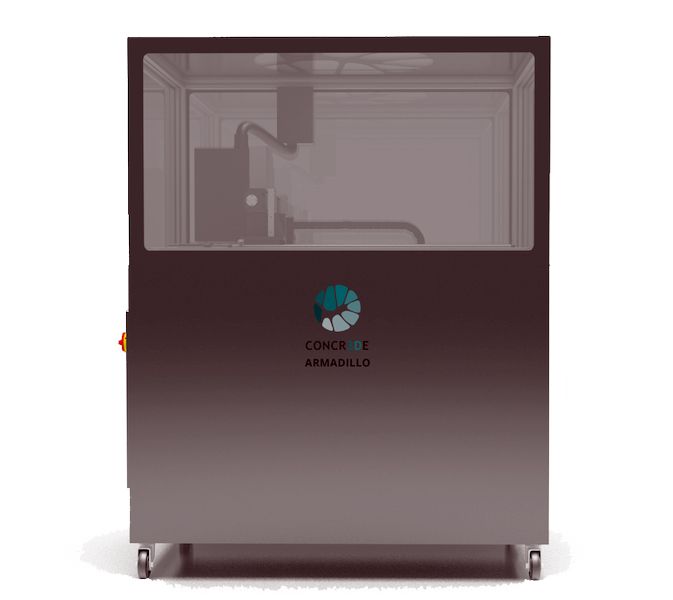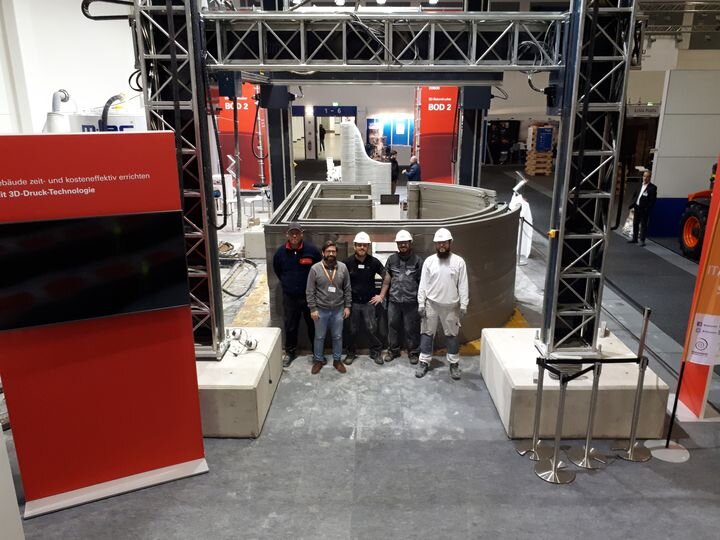![The Armadillo Black stone 3D printer [Source: Concr3de]](https://fabbaloo.com/wp-content/uploads/2020/05/image-asset_img_5eb0987b9dcf3.jpg)
I’m looking at the equipment provided by Concr3de, which can 3D print in stone.
The Rotterdam-based company has developed a binder jet / powder process that can successfully produce stone-like objects. In their system, a high DPI printhead moves swiftly across a flat bed of powder, selectively depositing liquid binder.
The company supplies three basic materials for their equipment: Gray or white stone, each of which provides strong compressive and tensile strength for producing sculptural objects; and foundry sand, which may be used to produce ceramic molds for casting purposes. This material has a maximum temperature of 1600C, making it flexible for this purpose.
![The Concr3de stone 3D printing process [Source: Concr3de]](https://fabbaloo.com/wp-content/uploads/2020/05/image-asset_img_5eb0987bea5d9.jpg)
More importantly, Concr3de allows operators to experiment with their own material mixes, which could be of an infinite variety. The company provides a selection of different binders to assist in this work.
Concr3de sells two different 3D printing devices that make use of their technology, the Armadillo Black and Armadillo White. Each device provides a build volume of 300 x 300 x 300 mm, and has a printhead capable of 400 DPI. They say the minimum wall size for both of their materials is a mere 2mm, so these devices can produce very finely detailed results.
![Standard stone 3D printing materials for the Armadillo printers [Source: Concr3de]](https://fabbaloo.com/wp-content/uploads/2020/05/image-asset_img_5eb0987c33f18.jpg)
Printing speed is always a significant concern, but it seems that the two Armadillo devices are quite speedy. They both can print at a published 4 cm/hr rate. This means that in theory one could print a full build volume object in only 7.5 hours.
By segmenting a 3D model into several parts, one could easily accommodate a large sculpture in the relatively small build volume of these devices. The segments would need only to be fastened together after printing.
While there are two devices in Concr3de’s product line, everything I’ve mentioned seems to be identical between them. But there is a significant difference.
The Armadillo White device is classified as an “Open System”, meaning the operator is fully capable of tweaking the printing parameters, materials, and even hardware. This means the White system is perfectly designed for experimentation in developing unique stone mixes.
One could custom design a material mix that would exactly match the engineering requirements for a given application using the Armadillo White.
Concr3de says you can print “geopolymers, ceramics, metals, plastics and cementitious materials”, so the machine is quite a bit more flexible than you may have assumed. However, I suspect some of these materials would require post-processing steps to complete their production. For example, metal 3D prints likely require sintering in a furnace.
There seem to be many applications for this technology, but many appear to be structural elements for the exterior of buildings, or standalone sculptural features. It’s also possible to develop complex molds for advanced casting applications.
Concr3de does not seem to publish pricing for their equipment or materials, so if you’re interested in their equipment you’ll have to contact them directly for a quote.
Via Concr3de











FELIXprinters has released a new bioprinter, the FELIX BIOprinter, which is quite a change for the long-time 3D printer manufacturer.